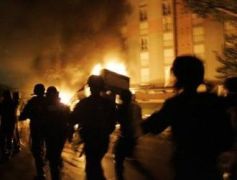anniversary, for better or worse



There's been a buzz around Paris w/r/t October 27, 2006: one year on from the death of two youths in Clichy-sous-bois, a poor neighborhood outside of Paris, who ran into an electrical grid while most likely fleeing police. The event sparked "riots" across the cités (large housing projects) of the banlieue (suburbs), from Clichy-sous-bois to the rest of Paris's suburbs to every major city in France (to even, as I just learned, Guadeloupe). They were vastly mischaracterized in the American press -- I recall, for example, a New York Times' editorial entitled "Paris is Burning", when the point was precisely that Paris was completely calm while the periphery had erupted into a conflagration. Or perhaps it was just a question of emphasis. Setting cars on fire was the typical MO, but it was only buried deep in an article that I would find a sentence along the lines of "riots in the French suburbs subsided last night as the number of car burnings dropped to average levels." Those average levels, meanwhile, were something like several hundred cars a night! Sure, the sharp spike was something to take notice of, but the basic act of protest wasn't anything new.
So I'm not surprised to read, as in this BBC piece, "The conditions that led to the 2005 unrest are still in place." That seems to be the main conclusion drawn by the outpouring of banlieue commentary. Le Monde, the country's leading newspaper, has certainly wanted their fill: an 8-page supplement on Thursday and the cover of their political magazine.


The two features make for an instructive contrast. On the left, "Banlieues un an après" (Banlieues one year after), and on the right, "Trente ans d'histoire et de révoltes" (Thirty years of history and revolts). The former is stuck in a naïve mindset, one that I imagine was shocked such events could happen in the first place and certainly hasn't learned much since, even though, for example, a popular movie like La Haine came out over ten years ago! Why talk of one year after when it's really a question of, as the latter seems to better understand, thirty years before?
Or longer, for that matter. Between 1945 and 1971, approximately 6.5 million units of housing were built in France. At an average occupancy of 4 persons per unit, that's 26 million people. In 1971, the population of France was roughly 50 million people. Astounding rates of post-war growth and construction? Sounds like a baby boom to me, not a big deal. Except that of those 6.5 million units of housing, 2 million were HLM (habitation à loyer modéré -- rent-controlled housing, aka cités) and 3 million were publicly financed in some manner. Given that those 3 million aren't necessarily all cités of some kind, you can calculate that roughly 15-35% of the French lived in such projects. And that was in 1971. Wikipedia picks up the slack and brings it to the present day: There are now approx. 4 million HLM housing units, home to roughly 14 million people, or one-quarter of France's population.
What makes cité life provoke such hostile reactions? Certainly there are obvious economic and cultural reasons: high unemployment, endemic job discrimination (a plan to institute anonymous résumés -- so employers can't immediately toss their Mohammets into the rejection pile because they're looking to hire Jacques -- recently got scrapped in the National Assembly), and the resentment of outsider status. Huge problems for which I'm hardly equipped to provide solutions.
A more manageable question, however, might center around where and how the violence was carried out. It struck me that, as far as I could tell from media coverage, those perpetrating the unrest mostly were doing so in their own neighborhoods. Paris proper was untouched for a reason, in that sense -- the geography of the banlieues keeps them a substantial train ride away. Granted, I have seen some bidonvilles tucked into corners along the Seine, but I have to imagine anyone squatting on central Parisian real estate wants to lay low (bidonville can refer to anything from a "tent city" to a "shanty town" -- in this case I'm referring to more of the former, the rows of tents you can find on some of the left bank quais).
So there's a geographical segregation, coupled with a built environment that, on the whole, isn't very appealing: large, co
 ncrete apartment blocks. Lots of them. Moreover, and maybe even more importantly, they've been provided by the government. Crucially, this means there's no sense of ownership. Of course, no one was ready to go torch their homes, but to burn cars, police stations, even schools and community centers -- to add a lot of charred wreckage to an already bleak landscape -- probably wasn't accompanied by a lot of tears. An environment like that just doesn't engender a lot of attachment.
ncrete apartment blocks. Lots of them. Moreover, and maybe even more importantly, they've been provided by the government. Crucially, this means there's no sense of ownership. Of course, no one was ready to go torch their homes, but to burn cars, police stations, even schools and community centers -- to add a lot of charred wreckage to an already bleak landscape -- probably wasn't accompanied by a lot of tears. An environment like that just doesn't engender a lot of attachment.Naturally, I can't help but think about favelas in Rio by comparison -- where it's the exact opposite. Of course social unrest has occurred in the city for decades. The '90s in particular were considered something of a nadir, as I've been reading in Cidade Partida ("Divided City"). Of particular note in light of the banlieue are the clashes between funkeiros that occurred on the beaches of Ipanema and Copacabana (around '93, I believe). When tension reached a head, they didn't destroy their own communities -- precisely because their communities are their own. I can't imagine anyone setting a car in their own favela on fire. The sense of pride and resilience is simply too strong. Destruction caused by warring gangs is of course another story, but I've never heard of a gang tearing down a favela -- that's the kind of thing the government is more likely to propose.
In Rio the poor build themselves homes they are proud of in spite of the government so they don't always have to live peripherally. / In Paris the government builds homes for the poor they have no attachment to and forces them to live peripherally.
So when Rio's huddled masses want to be heard, how do they do it? Throw a baile funk. Let that bass trickle down the hillsides -- and yes, you can be in a neighborhood of the asfalta and hear the soundsystem up on the morro. And outside Paris, they let flames cascade upward, hoping those lucky enough to be inside the Boulevard Périphérique look up & notice.
all just ways of rendering the invisible visible, some more destructive than others.
____
Easy to get grandiose & general, which can be dangerous & dishonest. To refocus:
1. banlieue, like favela, is a vastly overwrought term at this point, and can hardly be spoken of in monolithic terms
2. the cités are also there to stay -- it's a fait accompli: there's no chance the government is going to rip them all down and somehow integrate millions of people into already-dense Paris
3. so what's going on besides focusing on violence (of which, fortunately, there doesn't seem to have been any to "mark" the anniversary)? besides the same kind of sensationalization you deplored in opinions of favelas?
Well, Le Monde Diplomatique, the magazine cover on the right side that I never got back to, already seems to be pointing in that direction. The inside flap ad
 sets the tone dramatically. "Banlieues: A positive energy!", "Creative Banlieues", "The Culture of the Cités." The "Banlieue One Year After" insert deserves some credit too, even if I don't like the presentation. In a particularly carioca moment, there's an article on the resident of a cité in Marseille who proudly shows off a commanding view of the city, port, and ocean that only his home turf offers.
sets the tone dramatically. "Banlieues: A positive energy!", "Creative Banlieues", "The Culture of the Cités." The "Banlieue One Year After" insert deserves some credit too, even if I don't like the presentation. In a particularly carioca moment, there's an article on the resident of a cité in Marseille who proudly shows off a commanding view of the city, port, and ocean that only his home turf offers.I'm wondering too, with all the downtime unemployment offers, if there's a music scene of some kind stirring about on the outskirts of town & more importantly how I can find it. Le Monde was fascinated a week ago (en français, sorry) with one way the bored youth pass their time: blogging. The subtitle (translated) reads, "The cités of the banlieue play out rivalries with one another on the Net via hundreds of blogs. They're violent, territorial, provocative. Choice excerpts -- with their spelling." [the posts are full of slang, esp. verlan, where the syllables of a word are reversed. merits its own analysis some other time.]
The author of this piece clearly doesn't have a healthy sense of exaggeration. Someone's profile reads, "Welcome to Mureaux. Number of residents: around 30,000. Crime rate: 97%. Chance of visiting & leaving alive: Almost nil. From the moment you pass the sign, the game begins." Maybe Mureaux really is that rough, but I detect a pretty obvious tough guy façade there. It fits in line with what the article quotes at the beginning, that the blogs argue over which neighborhood is the scariest, "the hottest," "the ghettoest." Again I can't help but compare: the youth of the favela will instead take pride in having the best baile around.
I would link to some of the blogs -- and indeed have been meaning to try and contact the authors -- but as I just discovered, their host shut them all down for "not following the terms of the website." Somehow not surprising.
So where does that leave me? I didn't come to Paris to visit cités in the same way that favelas were an integral part of my plans in Rio. But I'm absolutely of the mindset that all parts of a city deserve attention -- peripheries as much as centers. It's remarkable how effective out of sight/out of mind is: I couldn't help but be reminded of favelas every day in Rio, while it's taken this artificial anniversary to get me thinking more seriously about the banlieue.
And yet, three days a week I'm heading to St-Denis (a municipality that, technically, is in the banlieue) for my classes at Université-Paris-VIII, the most radical of the post-'68 campuses (psychoanalysis program founded by Lacan, philosophy dept founded by Foucault . . . you get the idea). The kind of place that even has an academic program on connaissance (familiarity or knowledge) de la banelieue. Soon enough, I suppose: I'm taking a class on the problems cities face in the era of globalization, and the professor promised to give me a list of architecturally- or archetypically-significant sites around the région parisienne w/r/t all this suburban fury.
___
Quick parting shot, from a random AP article reporting on last fall:
"The emergency decree invoked a 50-year-old security law that dates to France's colonial war in Algeria that empowers officials to put troublemakers under house arrest, ban or limit the movement of people and vehicles, confiscate weapons and close public spaces where gangs gather."
Those colonial entanglements never do go away, do they?

0 Comments:
Post a Comment
<< Home